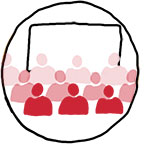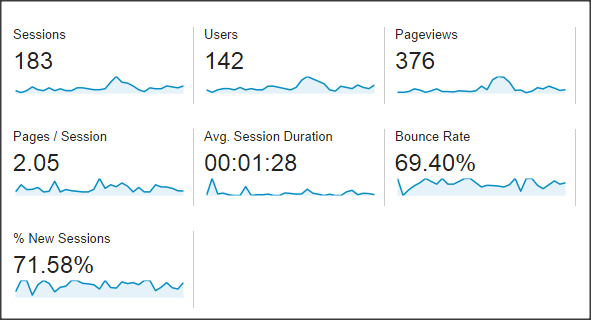In previous weeks we saw how you can use Google Analytics to set goals on your website or blog and get valuable information about your audience.
But if you want your analysis to be useful, you have to interpret the results, identify weaknesses and promote solutions. In this article I will suggest some improvements that can help you especially if you noticed a high bounce rate.
Visitors and average session length
As we saw in the post above mentioned, with Google Analytics you can easily find the average duration of your website’s session and even make a comparison according to the channel through which your visitors came. This data allows you to ask yourself if your content is meeting the needs of different groups of visitors with different interests and expectations, and can provide you with information on questions such as:
- Do people who come to your blog find what they want? Does your content meet their expectations?
- Where is the audience that is most interested in your content?
- Is your bounce rate too high?
I recently read an article with the story of a cartoonist who, thanks to a link that appeared on Reddit, saw an increase of 25,000% on his website traffic, but still only sold 23 extra copies of his book.
A traffic increase itself doesn’t have to be beneficial in the same way that seeking to increase traffic at any cost may be counterproductive. The number of visitors and the session time are metrics that should reflect a relevant experience, both on your part and on the part of the visitor.
The bounce rate
According to Google, the bounce rate of a website represents the percentage of sessions in which there was only one interaction, ie, those where the visitor just viewed the page where he landed and then took no further action.
So the bounce rate should not be confused with the session time, although they are related, because both of them may well be indicative of some of these situations:
- The visitor entered the website with expectations that weren’t met.
- The visitor didn’t find the design or the usability of the website attractive.
The bounce rate is a subjective indicator. And that is up to the point that for two different webpages, a same ratio may be acceptable in one case, and in the other, a sign of things not going too well. For example, a technical support site is usually expected to have a high bounce rate, because once the user reads the article that addresses his specific question, he usually doesn’t browse other pages focused on issues that are not affecting him.
However, in the case of an author blog like mine, or a blog that posts articles with a certain level of depth with certain frequency, a high bounce rate is not a desirable outcome. Besides, sessions must achieve a minimum duration so that conversion rates (goals achievement) are also significant. For these reasons I think in my case, a low bounce rate indicates that people who come to my website are interested in my content.
Trying to reduce the bounce rate to zero should not become anybody’s obsession, in part because it’s out of our reach. There will always be people who come to my site by mistake or with expectations that won’t be matched, and I can only prevent that to certain extent. However, I will always have a margin to act and make some adjustments to benefit my metrics.
I don’t know what bounce rate is acceptable for your site, but I can tell you how to set a starting point. Just jump to your Google Analytics account, go to your Audience Overview, and you will see, at the right, a few key metrics like Sessions and Bounce Rate:
From this data and the results of your duration type goals (we learned in this post how to set them), you’ll have a basis from which to start working.
As far as I know, there is no magic formula to reduce the bounce rate and increase the time a person spends on a website, but in this list I set out some factors that influence those metrics, and that I hope will serve you to improve your blog or website.
What you can do to improve your website average session length
As I noted above, your goals and improvement measures will depend on your content, but in my case, if I have created a website and I notice visits are too low, I ask myself:
- Did I promise anything that wasn’t close to reality?
I’m sure you have heard about how beneficial it can be for your blog to appear between the first Google search results with SEO techniques such as the use of keywords in the post titles.
But a too pushy optimization not only can be penalized by Google algorithms, but also, using words that are not descriptive of the content you are promoting can be counterproductive. Every time you make a promise and break it, whenever you disappoint your readers, their trust in you will be reduced a little bit more.
Moreover, trying to convince a visitor that he will like an article that turns out not to be interesting at all is a waste of time for him and for you.
The best thing you can do to improve this point is to adjust your marketing to reality.
- Are my website visitors feeling disoriented?
With the popularization of Twitter, we tend to share “pills” of information that extract the content from its context. Has it ever happened to you that after clicking on a link attracted by the image or the copy and landing on the linked website, you felt disoriented?
Put yourself in the place of your audience and design your separate pages in a way that, if someone lands on one of them, he will immediately understand where he is and why he is there.
It may seem obvious, but it’s very important that, on any page of your website, you make visible its description and a menu that favours navigation between contents.
You can also consider customizing your 404 error page (that displays when someone visits a broken link), including your website’s home page link or a menu in it. If you use a blogging system like WordPress and your 404 error page doesn’t seem appropriate, there are plugins that can help you changing it.
- Does my post look bad?
We agree that the value you offer is in your content, but at least initially, a post consisting on a compact mass of impenetrable text won’t invite anybody to the reading.
Especially since in many cases, and until the contrary is proved, there will be other sites apart from yours and mine where visitors can obtain information or entertainment. Closing a website and looking for another one that looks more interesting is very easy for the user.
So I think that after writing a post you must reserve a few minutes to add an image or graphic, and above all, formatting the text (structuring and organizing in a hierarchy, applying styles, etc).
- Does my blog design leave much to be desired?
Creating a blog or a website with a friendly and usable design is increasingly easy for everybody, and therefore, users tend to tolerate much less sites that make difficult the navigation or don’t meet minimum standards.
My advice is that you choose a minimalist blog template or web design, that focuses and gives relevance to the content, that clearly prioritizes the information in a clear way and where images take up only the needed space.
Finally, there are some features that harm the user experience, such as pop ups or autoplayers, or in short, any element that shows up without prior notice blocking the navigation or attracting attention aggressively. If any of these elements is present at your page, you should consider whether they really provide any added value to you or your readers.
- Isn’t it a responsible design that suits different devices?
 You yourself can check on Google Analytics how many visitors access your content from mobile devices. And again, put yourself in the place of your readers. If your pages are not designed responsibly, that is, if they don’t adapt to the dimensions of each device automatically, the navigation of your website can become an uncomfortable experience.
You yourself can check on Google Analytics how many visitors access your content from mobile devices. And again, put yourself in the place of your readers. If your pages are not designed responsibly, that is, if they don’t adapt to the dimensions of each device automatically, the navigation of your website can become an uncomfortable experience.
If you use a blogging tool like WordPress, always make sure that the templates you choose have “liquid” or responsible designs, and before deciding for one, test it at least from a mobile phone, a tablet and a computer.
- Are my pages taking too long to load?
 Pingdom is an online application that tells you how long a webpage is taking to load breaking down the burden each of its files and functionalities add to the whole.
Pingdom is an online application that tells you how long a webpage is taking to load breaking down the burden each of its files and functionalities add to the whole.
If you post up in a webpage written with plain html, your contents will take much less time to load, but on platforms such as WordPress or Blogger, this time can be much higher. Perhaps you never wondered, but each plugin, widget, and embedded element on your website increases a little bit the load time, and the whole can actually damage the user experience.
Before installing an add-on, do a little bit of research or use Pingdom to know how it will affect the page loading. We often use unnecessary plugins or widgets that only duplicate the information or perform functions that the web itself already performs.
A second more or less may not seem like a big difference, but once more think that if your visitor doesn’t know you, he may not think that your content is so unique he won’t find the same information in a well-built webpage too. In addition, Google has acknowledged having into account the loading time of the sites when including them in their Web Search Ranking.
The load time a person is willing to tolerate is something subjective and you will find different opinions in this regard, but three seconds is often considered the ideal limit.
- Am I sharing the right contents with the audiences coming from each medium?
 Many people use twitter as a news feed around the topics that matter to them, and they may not have much time and prefer more concise and quick to read information. On the other hand, if someone comes to an article through a search engine, he may be more predisposed to spend more time checking out other of your articles.
Many people use twitter as a news feed around the topics that matter to them, and they may not have much time and prefer more concise and quick to read information. On the other hand, if someone comes to an article through a search engine, he may be more predisposed to spend more time checking out other of your articles.
That’s why you should reconsider if you’re using the right strategy to promote or share your content. Maybe twitter is reporting you a lot of traffic, but are you sure that the form and content of the articles that you share are suitable to hold the interest of those people?
The key is at your fingertips, in your own Google Analytics metrics. If you compare your results you may find that the traffic coming from other social networks like Google+ gives place to a lower bounce rate depending on what contents.
Besides, if your post are rather long, you may want to print two different reading speeds, for example by adding pictures, captions, titles with different sizes that organize a hierarchy, or featured fragments.
Finally, you can also create short versions of your posts, post infographics with highlighted data on twitter, or create a video from the key points.
In short, you must ensure the correspondence between your content and the needs of your audience depending on the moment and the channels by which they access your website.
- Am I encouraging the navigation between different contents of my site?
 After everything said before, this could seem contradictory, but a high bounce rate might actually mean that visitors are finding exactly what they wanted, but they had no incentive to continue browsing the site afterwards.
After everything said before, this could seem contradictory, but a high bounce rate might actually mean that visitors are finding exactly what they wanted, but they had no incentive to continue browsing the site afterwards.
Once you got a visitor, it’s in your hand to hold his interest so that he discovers more of your work that could be useful for him, and for this you just have to take into account some usability principles and adopt a few habits when you are writing and presenting your contents.
If you’re curious, stay tuned to the blog, because in the next few weeks I will publish an article focused on this last point that will help you favouring the navigation between different pages of your website and increasing the number of page views per session.
Conclusion
If you use your blog or website as a platform to promote your books or articles, Google Analytics can help you monitoring your results with different kinds of goals.
The number of page views per session indicates the level of interaction and harmony between your audience and your content. Although the most important factor to retain the reader’s interest is the quality and relevance of the content, there are other factors related to the design and usability that can also contribute to make the experience of visiting your site a successful one.
In this article we have seen some ideas that can help you improving your metrics, but it’s in your hands to assess the needs of your website and make the right decisions.







Leave a Reply